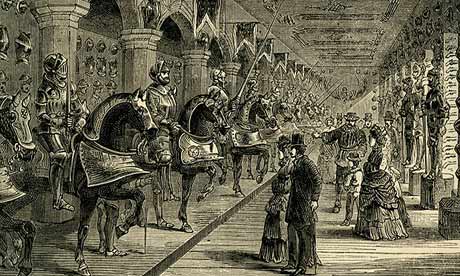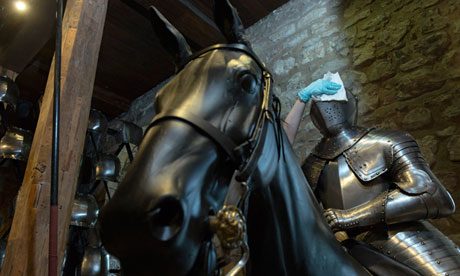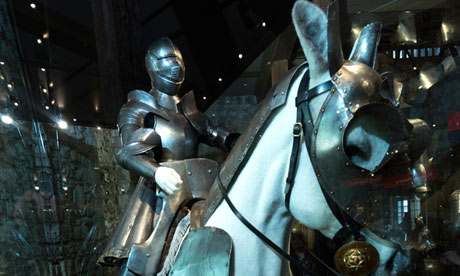Tower of London's Line of Kings continues 400-year-old narrative
One of Tower's oldest displays, a mix of historic treasures and fakes praised by a Dutch traveller in 1652, has been revamped

The Line of Kings at the Tower of London in 1878: 'One of the largest collections of 17th-century wooden sculptures on display anywhere,' says curator Thom Richardson
William the Conqueror has been deposed, along with Edward III and Henry V, and Elizabeth I has kept her head but lost her horse, but the survivors of one of the oldest tourist attractions in the world, suited and booted in shining armour, their horses pawing the ground and tossing their wooden manes, are almost ready to ride out again.
On Wednesday visitors to the White Tower, the oldest part of the Tower of London, will see the latest version of a display almost 400 years old, extolled in countless guide books, maps, journals and letters. In 1652 a Dutch diplomat, Lodewijck Huygens, wrote that he had been to see "wooden horses with armed men on them" – and the tall tales were also already in place, since he was shown not only the genuine armour of Henry VIII, but that of John of Gaunt, "a renowned warrior of a few hundred years ago".
"It was the one sight any visitor to London worth his salt had to see," said Thom Richardson, curator of armour at the Royal Armouries, which runs the White Tower within the Historic Royal Palaces Tower of London site.
 One of the exhibits in the Tower of London's new Line of Kings exhibition. Photograph: Christian Sinibaldi for the Guardian Even earlier wooden horses are known to have existed in Henry VIII's armoury at Greenwich palace, but to Richardson's disappointment, tests haven't identified any survivors, "nothing, not a sausage, not so much as a tin of horse meat".
One of the exhibits in the Tower of London's new Line of Kings exhibition. Photograph: Christian Sinibaldi for the Guardian Even earlier wooden horses are known to have existed in Henry VIII's armoury at Greenwich palace, but to Richardson's disappointment, tests haven't identified any survivors, "nothing, not a sausage, not so much as a tin of horse meat".
For centuries the line was a parade of genuine historic treasures, inspired mashups confected by generations of tower staff, and outright fakes, towering majestic figures claimed as all the kings of England since William in 1066, wearing their real armour, carrying their own swords, on wooden horses wearing their own beautifully engraved and decorated armour. In fact there were a few notable absentees, including Richard III.
At one date miniature suits of armour represented the Little Princes, the nephews many believed Richard murdered – and whose bones were firmly believed to be those found under a staircase only a few metres from where the visitors stood. It was typical of the mixture of genuine and confected history in the line: one of the dazzling miniature suits really was made almost 150 years later for another little prince who changed the course of English history: Henry, whose early death meant his sickly little brother became Charles I.
It's back in the line, near Charles's own gilded armour, in which he would have shone like a medieval saint, probably worn at the Battle of Naseby, which was on display all through the republican Commonwealth era after the execution of Charles.
Grinling Gibbons, regarded as one of the most brilliant woodcarvers ever, was paid £40 in 1685 for a horse and a carving of "the late king" a few months after the death of Charles II. A figure of Elizabeth I was commissioned, but only her head survives, though a former Tower historian, Geoffrey Parnell, believes her horse and her little page may lie in a pit under a car park a stone's throw from the Ritz, buried for protection in the first world war.
When the condition of the horses was checked – "by shining a light up their bottoms," project leader Karen Whitting explained – many proved perilously fragile, far too weak to carry a king. Some are still in armour, but most are now displayed as magnificent sculptures.
"This now represents one of the largest collections of 17th-century wooden sculptures on display anywhere", Richardson said. Kings including Henry VIII and Charles II are, shockingly, on foot. Generations of Royal Armouries staff were used to moving the horses by picking up a leg at each corner and manhandling them up stone spiral staircases, or dragging them by pulleys and hoists up the outside of the tower. This time specialist firms were brought in, and they are supported by discreet acrylic props.
 One of the exhibits in the Tower of London's new Line of Kings exhibition. Photograph: Christian Sinibaldi for the Guardian William the Conqueror was eventually booted out of the line in the 1820s, along with Edward III, John of Gaunt and Henry V, by one of the earliest and most distinguished armour historians, Samuel Meyrick, who regarded the display as a travesty: William, the victor of 1066, was in armour made in Greenwich more than 500 years after his death, and farsightedly brandishing a 17th-century musket.
One of the exhibits in the Tower of London's new Line of Kings exhibition. Photograph: Christian Sinibaldi for the Guardian William the Conqueror was eventually booted out of the line in the 1820s, along with Edward III, John of Gaunt and Henry V, by one of the earliest and most distinguished armour historians, Samuel Meyrick, who regarded the display as a travesty: William, the victor of 1066, was in armour made in Greenwich more than 500 years after his death, and farsightedly brandishing a 17th-century musket.
"Meyrick undoubtedly put it on a much more sound and scholarly footing," Richardson said, "but the trouble was when he had finished there was practically nothing left to represent the middle ages."
His predecessors embarked on a shopping spree, filling the gaps with genuine antiques, others made to look centuries older, and some magnificent fakes. Every object in the new display has been part of the historic line at some point, including a little wooden figure in armour who may be part of an ancient automaton clock.
The tradition of tall tales spun by the yeoman warder, or beefeater, guides is as old as the Line of Kings itself.
Richardson has kept a favourite plain black iron breastplate, punctured with several small holes and one enormous one. "It was bought for testing at a time when claimed bullet-proof armour was being made – which this patently was not." In the 18th century one ancient warder had a cherished anecdote of how the soldier wearing it had had most of his guts blown away by a cannon ball that passed right through him, but was patched up and did perfectly well. However, a royal visitor, Prince Frederick, promptly capped this with an outrageous yarn about a soldier whose head was split open so the two halves flopped on his shoulders, until his quick-witted friends bound it up with a handkerchief, the wounded man drank a pot of ale and recovered completely. The mortified warder, aware he was being cruelly mocked, never spoke to a visitor again.
The Line of Kings, Tower of London, re-opens on Wednesday, 10 July.
• This article was amended on 7 July 2013. A reference to miniature suits being made 300 years after the Little Princes was changed to "almost 150 years"
On Wednesday visitors to the White Tower, the oldest part of the Tower of London, will see the latest version of a display almost 400 years old, extolled in countless guide books, maps, journals and letters. In 1652 a Dutch diplomat, Lodewijck Huygens, wrote that he had been to see "wooden horses with armed men on them" – and the tall tales were also already in place, since he was shown not only the genuine armour of Henry VIII, but that of John of Gaunt, "a renowned warrior of a few hundred years ago".
"It was the one sight any visitor to London worth his salt had to see," said Thom Richardson, curator of armour at the Royal Armouries, which runs the White Tower within the Historic Royal Palaces Tower of London site.
 One of the exhibits in the Tower of London's new Line of Kings exhibition. Photograph: Christian Sinibaldi for the Guardian Even earlier wooden horses are known to have existed in Henry VIII's armoury at Greenwich palace, but to Richardson's disappointment, tests haven't identified any survivors, "nothing, not a sausage, not so much as a tin of horse meat".
One of the exhibits in the Tower of London's new Line of Kings exhibition. Photograph: Christian Sinibaldi for the Guardian Even earlier wooden horses are known to have existed in Henry VIII's armoury at Greenwich palace, but to Richardson's disappointment, tests haven't identified any survivors, "nothing, not a sausage, not so much as a tin of horse meat".For centuries the line was a parade of genuine historic treasures, inspired mashups confected by generations of tower staff, and outright fakes, towering majestic figures claimed as all the kings of England since William in 1066, wearing their real armour, carrying their own swords, on wooden horses wearing their own beautifully engraved and decorated armour. In fact there were a few notable absentees, including Richard III.
At one date miniature suits of armour represented the Little Princes, the nephews many believed Richard murdered – and whose bones were firmly believed to be those found under a staircase only a few metres from where the visitors stood. It was typical of the mixture of genuine and confected history in the line: one of the dazzling miniature suits really was made almost 150 years later for another little prince who changed the course of English history: Henry, whose early death meant his sickly little brother became Charles I.
It's back in the line, near Charles's own gilded armour, in which he would have shone like a medieval saint, probably worn at the Battle of Naseby, which was on display all through the republican Commonwealth era after the execution of Charles.
Grinling Gibbons, regarded as one of the most brilliant woodcarvers ever, was paid £40 in 1685 for a horse and a carving of "the late king" a few months after the death of Charles II. A figure of Elizabeth I was commissioned, but only her head survives, though a former Tower historian, Geoffrey Parnell, believes her horse and her little page may lie in a pit under a car park a stone's throw from the Ritz, buried for protection in the first world war.
When the condition of the horses was checked – "by shining a light up their bottoms," project leader Karen Whitting explained – many proved perilously fragile, far too weak to carry a king. Some are still in armour, but most are now displayed as magnificent sculptures.
"This now represents one of the largest collections of 17th-century wooden sculptures on display anywhere", Richardson said. Kings including Henry VIII and Charles II are, shockingly, on foot. Generations of Royal Armouries staff were used to moving the horses by picking up a leg at each corner and manhandling them up stone spiral staircases, or dragging them by pulleys and hoists up the outside of the tower. This time specialist firms were brought in, and they are supported by discreet acrylic props.
 One of the exhibits in the Tower of London's new Line of Kings exhibition. Photograph: Christian Sinibaldi for the Guardian William the Conqueror was eventually booted out of the line in the 1820s, along with Edward III, John of Gaunt and Henry V, by one of the earliest and most distinguished armour historians, Samuel Meyrick, who regarded the display as a travesty: William, the victor of 1066, was in armour made in Greenwich more than 500 years after his death, and farsightedly brandishing a 17th-century musket.
One of the exhibits in the Tower of London's new Line of Kings exhibition. Photograph: Christian Sinibaldi for the Guardian William the Conqueror was eventually booted out of the line in the 1820s, along with Edward III, John of Gaunt and Henry V, by one of the earliest and most distinguished armour historians, Samuel Meyrick, who regarded the display as a travesty: William, the victor of 1066, was in armour made in Greenwich more than 500 years after his death, and farsightedly brandishing a 17th-century musket."Meyrick undoubtedly put it on a much more sound and scholarly footing," Richardson said, "but the trouble was when he had finished there was practically nothing left to represent the middle ages."
His predecessors embarked on a shopping spree, filling the gaps with genuine antiques, others made to look centuries older, and some magnificent fakes. Every object in the new display has been part of the historic line at some point, including a little wooden figure in armour who may be part of an ancient automaton clock.
The tradition of tall tales spun by the yeoman warder, or beefeater, guides is as old as the Line of Kings itself.
Richardson has kept a favourite plain black iron breastplate, punctured with several small holes and one enormous one. "It was bought for testing at a time when claimed bullet-proof armour was being made – which this patently was not." In the 18th century one ancient warder had a cherished anecdote of how the soldier wearing it had had most of his guts blown away by a cannon ball that passed right through him, but was patched up and did perfectly well. However, a royal visitor, Prince Frederick, promptly capped this with an outrageous yarn about a soldier whose head was split open so the two halves flopped on his shoulders, until his quick-witted friends bound it up with a handkerchief, the wounded man drank a pot of ale and recovered completely. The mortified warder, aware he was being cruelly mocked, never spoke to a visitor again.
The Line of Kings, Tower of London, re-opens on Wednesday, 10 July.
• This article was amended on 7 July 2013. A reference to miniature suits being made 300 years after the Little Princes was changed to "almost 150 years"
